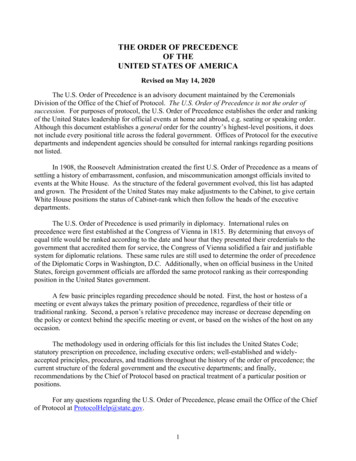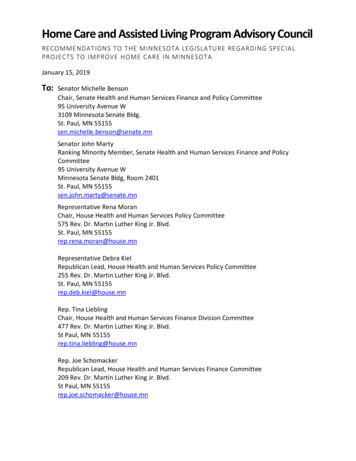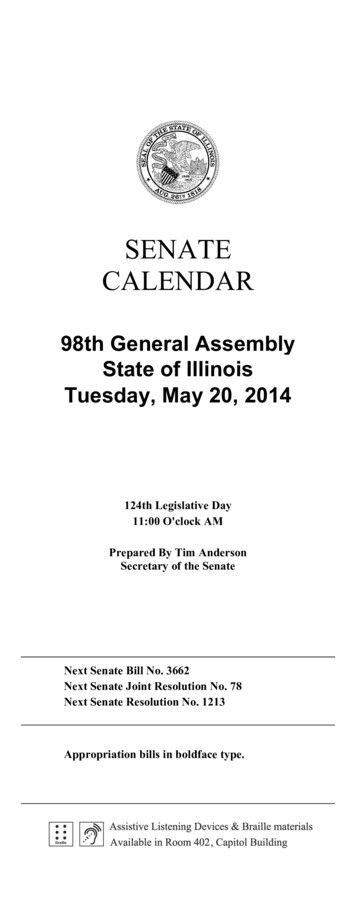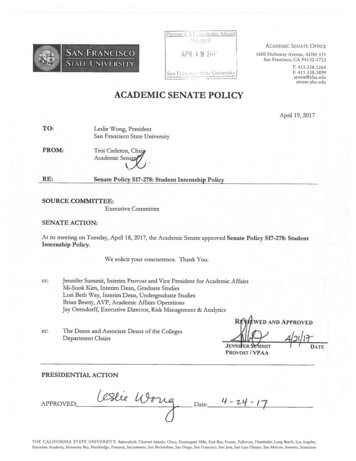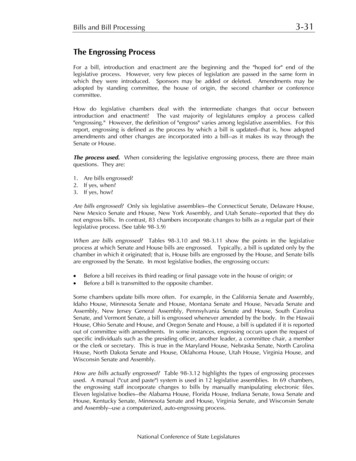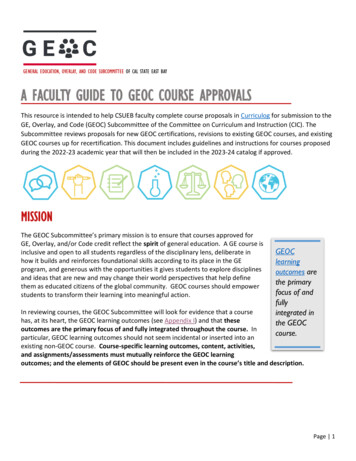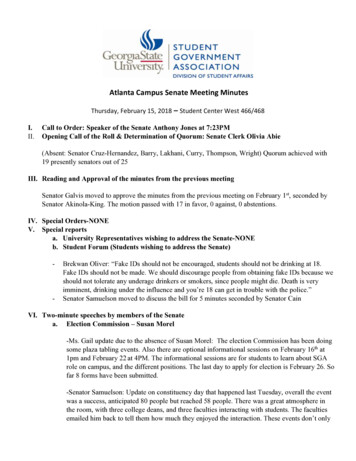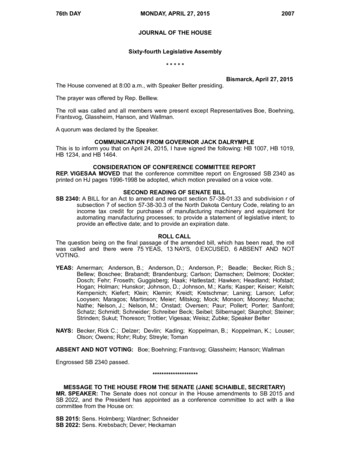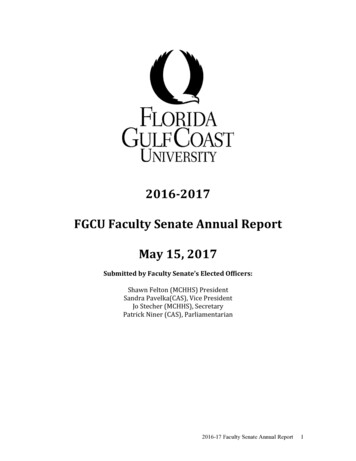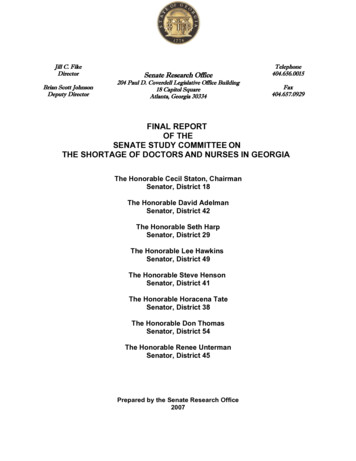
Transcription
Jill C. FikeDirectorBrian Scott JohnsonDeputy DirectorSenate Research Office204 Paul D. Coverdell Legislative Office Building18 Capitol SquareAtlanta, Georgia 30334Telephone404.656.0015Fax404.657.0929FINAL REPORTOF THESENATE STUDY COMMITTEE ONTHE SHORTAGE OF DOCTORS AND NURSES IN GEORGIAThe Honorable Cecil Staton, ChairmanSenator, District 18The Honorable David AdelmanSenator, District 42The Honorable Seth HarpSenator, District 29The Honorable Lee HawkinsSenator, District 49The Honorable Steve HensonSenator, District 41The Honorable Horacena TateSenator, District 38The Honorable Don ThomasSenator, District 54The Honorable Renee UntermanSenator, District 45Prepared by the Senate Research Office2007
TABLE OF CONTENTSI.EXECUTIVE SUMMARY .3II.INTRODUCTION.4III.COMMITTEE FINDINGS.5A.B.C.D.E.IV.The Physician Shortage.5The Medical Education System.6Medical Education Costs and Healthcare Economics.8The Nurse Shortage.8The Nursing Education System.9COMMITTEE RECOMMENDATIONS.10A. Physicians.10B. Nurses.11
I.EXECUTIVE SUMMARYGeorgia is facing a severe shortage of physicians and nurses. With one of the fastest growingpopulations in the nation, the U.S. Census Bureau ranks Georgia as the 9 th most populous stateand estimates that our state will add nearly 3 million new residents by the year 2020. In MetroAtlanta alone, the population has more than doubled to nearly 4.4 million over the last threedecades. Along with this dramatic population growth, Georgians are also aging and demandinggreater levels of care. Georgia’s elderly population is expected to increase from 9.6 percent to15.9 percent of the total population by 2030.Furthermore, Georgia’s medical professionals are also growing older. Baby boomers are facingretirement, and the rate at which new doctors and nurses are added to the state’s workforcecontinues to decline. New data gathered by the American Medical Association indicates thatGeorgia ranks 40th in the nation with regard to the per capita number of practicing physiciansand 42nd in its per capita supply of registered nurses. As the population continues to age andexpand, our state will ultimately require the introduction of a large number of new medicalprofessionals just to maintain its current workforce capacity.At the same time, the medical and nursing education systems in Georgia are struggling to keepup with the pace of demand for more doctors and nurses. Physician residency programs havenot been enhanced to meet the number of students entering Georgia’s medical schools, andnursing schools are facing a drastic shortage of faculty due to retirements and a lack ofcompetitive salaries. Without significant and immediate state action, there will be even fewerphysicians and nurses than today, caring for an additional 3 million residents in 2020.In response to these concerns, the Senate Study Committee on the Shortage of Doctors andNurses in Georgia was established pursuant to Senate Resolution 66 to examine ways in whichthe Legislature can promote the increase of Georgia’s physician supply and its supply of nurses.After many hours of testimony and careful consideration of the information presented, theCommittee agreed that our state is facing an alarming shortage of medical professionals. TheCommittee recognized that, in order to sustain its economic viability and promote the health andquality of the life of its residents, Georgia must ensure that it has a strong healthcare systemwith a sufficient number of both doctors and nurses. Therefore, our state must respond to theimpending shortages and build a sufficient medical workforce to meet the increased needs ofthe growing, aging population. Finally, the Committee agreed that the primary focus of any stateaction should be within the medical and nursing education systems, specifically by expandingmedical education enrollment and physician residency training, and increasing nursing facultysalaries and doctoral programs.3
II.INTRODUCTIONThe Senate Study Committee on the Shortage of Doctors and Nurses in Georgia was createdpursuant to Senate Resolution 66 during the 2007 Legislative Session. The Committee wascharged with undertaking a study of Georgia’s current physician and nurse capacity andaddressing ways in which the Legislature can promote increasing the supply of both doctors andnurses in our state. The Committee was asked to make any recommendations, includingsuggestions for legislation, that it deemed necessary.The Committee was composed of the following members: Senator Cecil Staton, Chairman;Senator David Adelman; Senator Seth Harp; Senator Lee Hawkins; Senator Steve Henson;Senator Horacena Tate; Senator Don Thomas; and Senator Renee Unterman.The Committee held five meetings across the state: September 13, 2007 at Mercer UniversitySchool of Medicine in Macon; October 4, 2007 at Georgia Southern University School ofNursing in Statesboro; October 25, 2007 at Emory University School of Medicine in Atlanta;November 29, 2007 at Morehouse School of Medicine in Atlanta; and December 13, 2007 at theState Capitol, sponsored by the Medical College of Georgia.During its meetings, the Committee heard testimony from numerous medical professionals andstakeholders, including: Dr. Bill Underwood, President, Mercer University; Dr. Martin Dalton,Dean, Mercer University School of Medicine; Mr. Benjamin Robinson, Executive Director,Georgia Board for Physician Workforce; Dr. Joe Sam Robinson, Georgia Neurosurgical Institute;Dr. Fred Girton, Department of Family Medicine, Mercer School of Medicine and Medical Centerof Central Georgia; Dr. Jean Bartels, Chair of Nursing, Georgia Southern University; Dr. DonnaHodnicki, Professor of Nursing and MSN Program Director, Georgia Southern University; Ms.Mary Anderson, Chief Nursing Officer, East Georgia Regional Medical Center; Ms. CaroleJakeway, Chief Nurse, Georgia Department of Human Resources, Division of Public Health; Dr.Rosemarie Parks, District Health Director, Southeast Health District; Dr. Dawn Cartee,Department of Technical and Adult Education; Dr. Lucy Marion, Chair, Georgia Board ofRegents’ Task Force on Nursing Education and Dean, Medical College of Georgia School ofNursing; Dr. Thomas Lawley, Dean, Emory University School of Medicine; Dr. Bill Eley,Executive Associate Dean for Medical Education and Student Affairs, Emory University Schoolof Medicine; Dr. Jim Zaidan, Associate Dean for Graduate Medical Education, Emory UniversitySchool of Medicine; Dr. Lisa Eichelberger, Dean, Clayton State University School of Nursing andChair, Georgia Association of Nursing Deans and Directors; Dr. Maureen Kelley, EmoryUniversity School of Nursing; Dr. John Maupin, Jr., President, Morehouse School of Medicine;Dr. Daniel Rahn, President, Medical College of Georgia; Mr. Raj Sabharwal, Senior Researcher,Center for Workforce Studies, Association of American Medical Colleges; Ms. Terry Durden,Interim Assistant Vice Chancellor, Georgia Board of Regents, Office of Economic Development;Mr. Michael McCann, Director of Legislation and Policy, Georgia Nurses Association; and Ms.Maria Kulma, Vice President of Patient Care and Chief Nursing Officer, Southern RegionalHealth System.4
III.COMMITTEE FINDINGSA. The Physician ShortageDuring its hearings, the Committee received compelling testimony regarding the physicianshortage in Georgia. Although Georgia is the 9th most populous state, it currently ranks 40th inthe nation in its physician-to-population ratio and 44th in its ratio of primary care physicians.1Georgia’s population is growing at an alarming rate and will ultimately require the introduction ofa large number of new doctors just to maintain its current capacity. In fact, our state’s populationis expected to grow by nearly 20 percent over the next decade. As the population continues toincrease, older Georgians are requiring greater levels of care, and baby boomer doctors areplanning for retirement. Ultimately, our state’s growing and aging population creates acontinuous, increasing demand for healthcare services that exceeds current workforce capacity.New data published by the Georgia Board for Physician Workforce (Board) indicates that,without immediate state action, Georgia will experience an overwhelming shortage of more than2,500 physicians by the year 2020 and will rank last in its ratio of physicians.2Unfortunately, even as new physicians enter the workforce in Georgia, the amount of workperformed is decreasing.3 Studies show that the new generation of doctors display differentperspectives toward the practice of medicine; they are working fewer hours and placing agreater emphasis on balancing work and home life.4 Similarly, the increasing presence ofwomen in medicine is also contributing to the overall reduction in work contribution. Womenoften bear a greater responsibility for managing family life and are therefore reducing theirworkload to meet demands at home. According to Mr. Benjamin Robinson, Executive Directorof the Board, the rapid population growth, combined with an increased demand for healthcareservices, a declining supply of doctors, and changing patterns in the practice environment andwork ethic, could effectively diminish the impact of any real growth in physician capacity,ultimately leading to a devastating shortage of doctors in our state.Testimony provided to the Committee further revealed that Georgia faces considerablechallenges in the availability of primary care doctors and core specialists. Primary care doctorsare important because they are considered to be the “gateway” into the entire healthcaresystem; they treat common medical problems and refer patients to specialists when necessary.Specialists, on the other hand, provide distinctive medical expertise. They are trained to providelevels of care beyond that of primary care doctors. Yet, current data suggests that access toboth primary care and core specialties is eroding. The proportion of primary care physicians ison the decline, specifically in the areas of Family Medicine, OB/GYN, and General Surgery.5General Surgery is especially important in rural communities that lack an adequate traumacenter. Consider that there are fewer General Surgeons per capita in our state today than thereTestimony given by Mr. Benjamin Robinson, Executive Director, Georgia Board for Physician Workforce,on September 13, 2007.2Id. See also Expanding Medical Education in Georgia, Roadmap for Medical College of Georgia Schoolof Medicine and Statewide Partners, Tripp Umbach Consulting Firm, as prepared for the Board ofRegents.3Id. See also Update on Georgia’s Physician Workforce, Follow Up Report to: “Is There A Doctor in TheHouse?”, Georgia Board for Physician Workforce, October 2006.4Id.5Id.15
were 10 years ago, with only 8.4 per 100,000 residents. Moreover, recruitment for specialistssuch as Oncologists, Cardiovascular Specialists, Urologists, and Radiologists continues to beminimal.6 According to the Board, the physician workforce must provide the skill set needed tocare for a growing, aging population. In other words, the state must have a sufficient number ofprimary care doctors and general surgeons, as well as an adequate supply of specialists to treatdiseases such as cancer and Alzheimer’s.Physician distribution is also a concern in Georgia. Large areas of our state are particularlyunderserved by a lack of primary care doctors, OB/GYNs, pediatricians, and an adequatetrauma network. It is significantly harder to attract and retain physicians in small, ruralcommunities, and many Georgians living in rural areas are forced to travel hours just to reach ahospital. A recent survey of physicians completing their final year of residency training inGeorgia revealed that only 4 percent had plans to practice in a rural area.7B. The Medical Education SystemPolicymakers and medical professionals who testified to the Committee suggested that theultimate solution to the physician shortage in Georgia is developing and maintaining a medicaleducation system that can produce enough doctors to meet the state’s increasing demands forservices. Currently, Georgia has five medical schools, four of which are private entities: Mercer University School of Medicine in Macon;Emory University School of Medicine in Atlanta;Morehouse School of Medicine in Atlanta;Philadelphia College of Osteopathic Medicine in Suwannee, which opened in 2005; andThe Medical College of Georgia in Augusta, the state’s only public medical school.Unfortunately, however, Georgia ranks 35th among the 45 states with medical schools in its percapita enrollment of medical students.8 Georgia’s medical education system is struggling tokeep up with the staggering population growth, and our state continues to rely on doctors fromother states and countries to supplement its workforce. Enrollment in our state’s medicalschools must be expanded to meet the increased need for doctors in Georgia.Nationally, the Association of American Medical Colleges (AAMC) has recommended that allmedical schools increase their enrollment by 30 percent by the year 2015. 9 Over the pastseveral years, Georgia’s medical schools have sought to meet these recommendations, and allfive schools have either increased their enrollment or made plans to do so. For example, theMedical College of Georgia, Georgia’s only state-operated medical school, recently announcedits plans to expand enrollment statewide from 745 to 1200 students by 2020, with significantexpansion in Augusta, along with a plan to open a new four-year campus in Athens inpartnership with the University of Georgia and two clinical campuses in Albany and Savannah. 10Similarly, Mercer University plans to increase its medical school enrollment by 50 percent byTestimony given by Mr. Benjamin Robinson, Executive Director, Georgia Board for Physician Workforce,on September 13, 20077See Physician Supply and Demand Indicators, A Survey of Georgia’s GME Graduates CompletingTraining in June 2006, Georgia Board for Physician Workforce, May 2007.8Testimony given by Mr. Benjamin Robinson on September 13, 2007.9Testimony given by Dr. Thomas Lawley, Dean, Emory University School of Medicine, on October 25,2007.10Testimony given by Dr. Daniel Rahn, President, Medical College of Georgia, on December 13, 2007.This expansion will require a minimum investment of 10 million by the state.66
opening a new campus in Savannah in the fall of 2008, 11 and Emory has increased itsenrollment by 15 percent.12 Morehouse School of Medicine has also expanded its class sizefrom 32 to 52 students and hopes to further expand to a total of 70 students by 2011. Finally,the Philadelphia School of Osteopathic Medicine opened a new medical facility in GwinnettCounty in 2006. However, even with an overall increase in enrollment at each medical school,Georgia still ranks well below the national average. Mr. Benjamin Robinson suggested to theCommittee that the state can address this issue by renewing its investment in medicaleducation, specifically by restoring funding to the Medical Student Capitation Program, whichpurchases slots for Georgia residents in the state’s private medical schools. This program couldeffectively increase the size of our physician workforce by ensuring that more graduates stay inthe state, since students originally from Georgia are more likely to practice here upongraduation.Ultimately, the biggest challenge facing the state’s medical education system is the lack ofgrowth in graduate medical education, or residency training programs. Residency programs aresignificant because they train and prepare doctors to practice a specific specialty. During theirresidency, doctors become active members of the community, which increases the likelihoodthat they will remain in the state to practice medicine. In fact, location of residency is thestrongest influence on the location of future practice. Research shows that graduates tend toestablish practice within a 50-mile radius of where they completed residency training.13 Georgiahas been successful with residency retention in recent years, with the 14th best retention ofresidency graduates in the nation.14 However, over the last decade, residency programs inGeorgia have only increased by a total of 13 percent.15 As medical school enrollment increases,so must the number of residency slots; otherwise, more of Georgia’s medical students will beforced to seek residency training in other states.Residency programs are typically sponsored by teaching hospitals, although medical schoolssometimes solely sponsor residents. Georgia currently has 10 teaching hospitals and 2000resident slots. Grady Memorial Hospital is the state’s premier teaching hospital and isextremely vital in training and producing new doctors for Georgia. Half of Georgia’s residentdoctors (approximately 1,000) are currently training at Grady, while 1 in 4 doctors practicingmedicine in Georgia completed training at Grady.16Consider also that no hospital has added a residency program to its operations since the year2000. This is largely due to the amount of money it costs to run a residency program—anaverage of 110,000 per resident per year.17 Although the state does provide some fundingthrough the Residency Capitation Program, the federal government is the largest source offunding for residency programs, as it pays for Medicare and Medicaid’s portion of medicaleducation costs. Unfortunately, in 1997, the federal government capped the number ofresidency slots that it will pay for with the passage of the Balanced Budget Act. Residency slotswere capped that year for cost-saving measures, and have not been increased to meet theTestimony given by Dr. Martin Dalton, Dean, Mercer University School of Medicine, on September 13,2007.12Testimony given by Dr. Thomas Lawley on October 25, 2007.13Testimony given by Dr. Fred Girton, Chief of Family Medicine, Mercer University School of Medicine, onSeptember 13, 2007.14Id.15Testimony given by Dr. Jim Zaidan, Associate Dean for Graduate Medical Education, Emory UniversitySchool of Medicine, on October 25, 2007.16Id.17Testimony given by Dr. Daniel Rahn on December 13, 2007.117
needs of the growing population. Residency training must be expanded to accommodate thegrowth in medical school enrollment and to increase the supply of physicians across the state.C. Medical Education Costs and Healthcare EconomicsThe rising cost of medical education is also affecting the physician workforce. Reports publishedby the AAMC in 2004 and 2005 showed a significant increase in the cost of tuition. Since the1980s, tuition has increased dramatically across the country—by 165 percent for privatemedical schools and over 300 percent for public schools. 18 In Georgia, three medical schoolshad double-digit increases in tuition in just one year.19 Most students must obtain outside loansand scholarships to cover the costs of their medical tuition and are left with a large amount ofdebt after graduation. In fact, nearly half of graduating physicians have medical education debtin excess of 80,000, and 1 in 10 reported debt in excess of 200,000.20 Graduates of privatemedical schools typically have greater debt, because tuition rates of private institutions arehigher than public schools. Data collected by the Board showed that Georgia medical schoolgraduates experience greater indebtedness than graduates from other states, as our state isheavily reliant on its four private medical schools.21 This type of debt can impact specialtychoice and interest in rural practice, thereby creating issues with physician distribution inGeorgia.Another aspect of the medical education system that is often overlooked is the training of futurephysicians in the business of healthcare economics. According to testimony presented to theCommittee by Dr. Joe Sam Robinson, Georgia Neurosurgical Institute, physicians play animportant role in healthcare cost savings. Dr. Robinson suggested that medical schools inGeorgia should focus on training physicians in healthcare economics and efficiencies as ameans of reducing unnecessary healthcare costs. Ultimately, Georgia needs a curriculum totrain future physicians in healthcare efficiencies that they can implement in their clinical practice.D. The Nurse ShortageIn addition to examining the shortage of physicians in Georgia, the Committee also addressedour state’s drastic shortage of nurses. During its meetings, the Committee received testimonyfrom nursing faculty from several area schools, practicing nurses from local health systems, theGeorgia Nurses Association, the Georgia Hospital Association, and the Georgia Board ofRegents regarding current barriers to the practice of nursing. As the 9th most populous state,Georgia ranks 42nd among all states in its supply of Registered Nurses (RNs) and 48 th inadvanced practice nursing care.22 The Georgia Board of Regents Task Force on HealthProfessionals Education (Task Force) has deemed nursing as “the most fragile and in need ofattention” of all medical professions in this state.Those who testified before the Committee stressed that the ability to obtain adequate nursingworkforce data is necessary in confronting the nurse shortage in our state. As many as 30Testimony given by Mr. Ben Robinson on October 25, 2007.Id.20See Update on Georgia’s Physician Workforce, Follow Up Report to: “Is There A Doctor in TheHouse?”, Georgia Board for Physician Workforce, October 2006.21Id.22Testimony given by Dr. Jean Bartels, Chair , Georgia Southern University School of Nursing, onOctober 4, 2007.18198
states have Centers for Nursing Workforce to collect and analyze nursing workforce data.23Unfortunately, Georgia lacks a research center capable of obtaining such information. Thisdeficit has made it impossible to accurately predict the current and future demand for nurses inour state. Although regulatory agencies and educational programs do collect different types ofinformation for various purposes, none include workforce planning. Without a uniform body tocollect and maintain workforce data in Georgia, the ability to isolate problems within the nursingworkforce and recommend actions is limited and incomplete. Therefore, the actual number ofexisting nursing professionals in Georgia is unknown. However, information gathered by theTask Force suggested that Georgia will need an additional 20,000 nurses by the year 2012 inorder to meet the demands of the growing, aging population. Even with a best-case scenarioand assuming all nursing graduates pass the licensure exam, remain in Georgia, and work fulltime, it is estimated that the state will only be able to produce a maximum of 12,000 RNs by theyear 2012.24 Based on its analysis, the Task Force predicted that our state will have a shortfallof 37,000 RNs by 2020.25The nurse shortage significantly affects patient safety, as nurses monitor and care for patients24-hours a day. High vacancy rates result in an increased nurse-to-patient ratio, which leads toincreased safety risks for patients. Currently, the nursing vacancy rate in hospitals and nursinghomes is 15 to 18 percent, with a 20 percent vacancy rate for public health nurses.26 TheAmerican Medical Association estimates that with every additional patient added to a nurse’sworkload, patient mortality increases by 7 percent; increasing a nurse’s workload from 4 to 8patients would lead to a 31 percent increase in patient mortality.27 Consider also that nursesoften work overtime and keep continuous 12-hour shifts due to staffing shortages. Researchshows that 93 percent of nurses report problems with maintaining patient safety because ofincreased workloads and mandatory overtime shifts. The Task Force estimated that there areapproximately 12,000 RNs currently licensed in Georgia who choose not to work as a nurse dueto job dissatisfaction.E. The Nursing Education SystemInformation presented to the Committee suggested that the nurse shortage can also beaddressed through improvements in nursing education. A lack of qualified nursing schoolfaculty, insufficient clinical sites, and poor classroom space are all significant factors contributingto the nursing shortage in Georgia. Georgia’s nursing programs are unable to admit 4,000qualified applicants each year because of these constraints, particularly the shortage of nursingfaculty.28 There is a 10 percent faculty vacancy rate in nursing schools across the state,primarily due to the lack of adequate compensation.29 In fact, salaries for nursing faculty are 20Testimony given by Mr. Michael McCann, Director of Legislation and Policy, Georgia NursesAssociation, and Ms. Maria Kulma, Chief Nursing Officer, Southern Regional Health System, onDecember 13, 2007.24Testimony given by Dr. Lisa Eichelberger, Dean, Clayton State University School of Nursing, on October25, 2007.25Testimony given by Dr. Lucy Marion Chair, Georgia Board of Regents’ Nursing Education Task Force,and Dean, Medical College of Georgia School of Nursing, on October 4 and December 13, 2007.26Testimony given by Ms. Carole Jakeway, Chief Nurse, Georgia Department of Human Resources,Division of Public Health, on October 4, 2007.27Testimony given by Dr. Donna Hodnicki, Professor of Nursing and MSN Program Director, GeorgiaSouthern University, on October 4, 2007, and Dr. Lisa Eichelberger on October 25, 2007.28Testimony given by Dr. Jean Bartels on October 4, 2007. Testimony also given by Ms. Terry Durden,Interim Vice Chancellor, Georgia Board of Regents, Office of Economic Development, on December 13,2007.29Id.239
percent ( 14,000 to 20,000) below market. Dr. Lucy Marion, Dean of the Medical College ofGeorgia’s School of Nursing and Chair of the Nursing Education Task Force, stated that nursingschools in Georgia are simply unable to compete with the better-paying salaries of clinicalnurses. The average salary for a faculty member with a master’s degree is 46,000; with adoctoral degree, the average is 63,000. However, in a clinical practice setting, the averagesalary for a nurse with a bachelor’s degree or less is between 63,000 and 78,000 annually.Any solution to the nurse shortage in our state will require strategies for increasing nursingfaculty compensation.Retirement of existing nursing faculty is also a concern. Approximately 41 percent of nursingprofessors in our state are age 55 or older, with 63 retirements planned in the next five years.30The retirement of experienced faculty leads to a loss of expertise, and the costs of training newfaculty are high. By 2010, faculty retirements will reduce the current enrollment capacity inGeorgia’s nursing schools by 26 percent, from a total of 10,260 to 7,500 students. Moreover,there has been a plummeting rate of graduate nursing degrees, which further exacerbates thefaculty shortage and leads to even more reductions in program capacity.31 The Board ofRegents recently approved Georgia Southern University’s proposal to implement a doctoralnursing program to enroll 30 students. However, graduate program productivity continues todecline; the University System of Georgia has only produced 15 doctoral nurses since 2000.Nursing schools in Georgia also need improvements to their clinical sites and simulation labs toallow the expansion of existing nursing programs. Clinical training sites are vital to the propertraining of nursing students, yet schools lack the necessary funding to upgrade and expandlaboratories, software, and simulation equipment. Testimony presented to the Committeesuggested that nursing education programs can be enhanced by increasing faculty salaries anddoctoral programs, as well as by improving existing nursing school infrastructures and clinicalsites.IV.COMMITTEE RECOMMENDATIONSAfter many hours of testimony and careful consideration of the information presented, theCommittee agreed that, in order to sustain its economic viability and promote the health andquality of life of its residents, Georgia must ensure that it has a strong healthcare system with asufficient number of medical professionals. The Committee further agreed that the GeneralAssembly must respond to the impending shortage of physicians and nurses in our state byfacilitating and supporting the expansion of the medical workforce necessary to meet theincreasing healthcare needs of our growing, aging population.A. Physicians Recommendation for Increasing Medical School Enrollment across the StateThe Committee recognizes that Georgia’s medical education system is struggling tokeep up with the staggering population growth, forcing the state to rely on doctors fromother states and countries. The Committee further recognizes that enrollment inGeorgia’s medical schools must be increased to ensure an adequate physicianworkforce. Therefore, the Committee recommends that medical schools in Georgiacontinue to increase enrollment for the purpose of producing more physicians. Giventhat the state has only one public medical school, increases will need to take place at3031Testimony given by Dr. Jean Bartels on October 4, 2007.Te
Nursing in Statesboro; October 25, 2007 at Emory University School of Medicine in Atlanta; November 29, 2007 at Morehouse School of Medicine in Atlanta; and December 13, 2007 at the State Capitol, sponsored by the Medical College of Georgia. During its meetings, the Committee heard testimony from numerous medical professionals and


